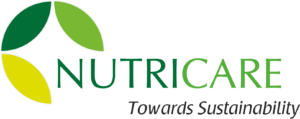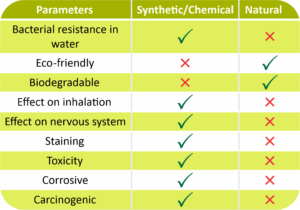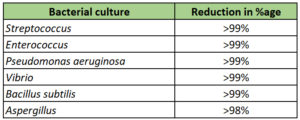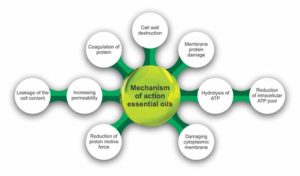Synopsis: The article suggests how essential oils possess natural antimicrobial
properties and can be adopted in disinfection activities, without possessing any negative and toxic side effects.
For poultry flock owners, disease prevention is essential. Basic disease prevention rules in a poultry operation, regardless of size, are:
- Adopt proper biosecurity plan or strategy
- Provide a balanced diet in each stage of bird’s life and fresh clean water to reduce stress.
- Practice good management with an all-in-all-out replacement program.
- Provide a good disinfection program
Disinfection: Prerequisite for effective biosecurity plan
The risk posed by disease inflicting organisms may be a constant challenge for birds. Instead of  trusting visual cleanliness, using effective management measures effectively combats this challenge. A surface that appears clean isn’t essentially disease-free, therefore could also be a failure to the bird’s management program.
trusting visual cleanliness, using effective management measures effectively combats this challenge. A surface that appears clean isn’t essentially disease-free, therefore could also be a failure to the bird’s management program.
Hygiene and disinfection play a major role in any effective disease control program for poultry production premises as they provide a safe pathogen-free environment with low microbial load to avoid disease conditions in farms, sheds, poultry houses, hatcheries, animal barns, machinery, feeders & drinkers, and working surfaces. Cleaning refers to the physical act of removing organic matter and solid debris (dirt, grease, feces, body fluids, etc.) and must always precede disinfection. It increases penetration and guarantees high-quality disinfection.
How proper disinfection can be achieved???
- Proper planning should be paramount step: Any good poultry house cleaning a1nd disinfection program should start with a plan, detailed date and time, along with the labor and equipment needed, should be established prior to disinfection activity.
- Control insects and pest: Wearing appropriate protective equipment, the poultry house interior should be sprayed with a locally recommended insecticide as soon as the flock is removed and while the house is still warm. A second treatment with insecticide should be completed before fumigation.
- Dust that harbors pathogens should be removed: Dust and cobwebs should be from interior surfaces and equipment.
- Pre-spray : Again, wearing appropriate protective equipment, detergent solution should be spayed throughout the broiler house interior to dampen any remaining dust. In open-sided poultry houses, the curtains should be closed first.
- All equipment should be removed from the house and raise automatic feeders and drinkers.
- Remove and dispose of litter: Litter must be removed to a distance of at least 3.2 km (2 miles) and disposed of in accordance with government regulations.
- Wash and clean house thoroughly: Use a pressure washer with a foam detergent. Ensure the detergent is compatible with the disinfectant to be used. Rinse with hot water.
Choosing the right disinfectant plays a vital role
A disinfectant’s effectiveness at destroying varied pathogens depends on its chemical composition, it’s mode of action and type of organism.
Now, the next question that arises is what characteristics should an effective disinfectant possess? For choosing right disinfectant one must consider it’s:
- Efficacy
- Cost
- Residual activity
- Activity with organic matter present
- Solubility
- Contact time
- Toxicity
- Effects on fabrics and metal surfaces
- Temperature
- Activity with soap
Cons of chemical disinfectants
Disinfection is important for clearing or transferring microorganisms, furthermore, acting as a barrier to microorganism’s transmission from animals to humans or contrariwise. Chemical disinfectants, on the opposite hand, considering their multifarious role and activity, have their own set of limitations. Alcohol, Cl compounds, formaldehydes, and different chemicals might irritate the skin and cause allergic eczema. They are sometimes poisonous, corrosive, form residue and are incompatible with plastic or steel feeding troughs. What is more, the application of chemical disinfectants in indiscriminate and unmonitored manner might lead to the unfold of microorganism resistance amongst environmental contaminants.
Why call for natural disinfection???

Given the drawbacks of disinfection with chemicals, a study was planned to assess the potential of an herbal disinfection that is equally effective as chemical agents but is fully safe to use, offers long-term disinfection, and is completely environmentally friendly due to its biodegradable nature.
Material and Methods
The present study was undertaken to evaluate the disinfection potential of a herbal biodegradable disinfectant. The environmental contaminants were exposed to NBD-99 to assess its effectiveness. Proper SOP was followed in order to test the antimicrobial action of the combination of essential oil, the disinfectant efficacy test. The subculture of Streptococcus, Enterococcus, Pseudomonas aeruginosa, Vibrio, Bacillus subtilis and Aspergillus were taken from stalk culture on media plates and challenged with the herbal disinfectant. The tests were performed as per guidelines of USP-37. The incubation temperature used 30-35◦C for bacterial cultures for 24 hours and 20-25◦C for 48 hours for fungal cultures.
Results and Discussion
The efficacy of green disinfectant against bacterial and fungal cultures is shown in Table 1. By using a green disinfectant there is >99% reduction in bacterial colonies of Streptococcus, Enterococcus, Pseudomonas aeruginosa, Vibrio & Bacillus subtilis while significant reduction of about >98% is observed against Aspergillus.

The constituents of green disinfectant such as Thyme, Pine and Eucalyptus oils are known for their antimicrobial effects (Tariq S et al., 2019; Dhakad AK et al.,2018; Chouhan S et al.,2017; Bachir and Benali,2012). Infact, in vitro disinfectant activity of essential oils against broad range of microbial, fungal, and viral species has been well studied and demonstrated (Cáceres, M et al.,2020; Brochot, A et al., 2017; Prabuseenivasan S et al.,2006.)

The antimicrobial activity of disinfectants can be attributed to its power of growth inhibition. The effectiveness of this essential oil-based disinfectant can be attributed to the actives present in essential oils which acted synergistically to destabilize the cell membrane, increased cell permeability as well as inhibited bacterial cell division (de Aguiar et al.2018; Swamy et al.,2016; Nazzaro et al., 2013; Celikel and Kavas, 2008; Martinez & Baquero,2000).
Swamy et al., (2016) specified the mode of action and mentioned that essential oils disrupt the cell membrane of the targeted pathogens by increasing membrane permeability, inducing leakage of vital intracellular constituents, and interrupting the cellular metabolism and enzyme kinetics of the targeted pathogens.
An acceptable activity of essential oils against gram‐positive and gram‐negative bacteria has been observed by de Aguiar et al. (2018).
The antifungal effect of the liquid disinfectant may be justified by the action of its actives, which inhibited fungal growth and spore formation and destabilized the cell organelle causing cell lysis (Tariq S et al.,2019). The antiviral effect of the disinfectant may be due to of inhibition of viral protein translation as well. Bansod and Rai (2008) in their study justified the use of mixed essential oils in case of mycotic infections. Similarly, disinfecting activity of the tea tree essential oil showed effective inactivation of captured fungal and bacterial aerosol on the filter surface (Huang et al. 2010; Pyankov et al. 2008). In yet another study, Pyankov et al., (2012) concluded that essential oils could be successfully used as effective disinfectant in bio-aerosol filtration applications.
The green disinfectant results may be correlated to the findings of Hendry et al., (2012) who demonstrated that essential oil formulations possess antimicrobial efficacy for potential disinfection and elimination of microbial biofilms from hard surfaces. They further suggested that, essential oils may be a useful adjunct to current infection control strategies. Besides this, according to a recent research result, the disinfectant spray made of the α-Terpineol effected the skin for 1 minutes could kill 99.996% Staphylococcus aureus, 99.998% Pseudomonas aeruginosa, 100% Escherichia coli and 100% Candida albicans. Exposure of same spray for 2 minutes on the skin could kill the 98.46% bacteria. (Center, B., & Cleaning, P. 2020).
Conclusion
Novel concept of green disinfection, using essential oil-based disinfectant has a great potential in the field of decontaminants and can be potential product to enhance biosecurity procedures. The green disinfectant is the ecofriendly alternative approach, which is non-toxic, non-corrosive and readily usable on nonporous hard surfaces as well as farm organic material. It not only has broad spectrum antimicrobial activity but also has anti-stress activity.
References 1) Cáceres, M., Hidalgo, W., Stashenko, E., Torres, R., & Ortiz, C. (2020). Essential Oils of Aromatic Plants with Antibacterial, Anti-Biofilm and Anti-Quorum Sensing Activities against Pathogenic Bacteria. Antibiotics (Basel, Switzerland), 9(4), 147. 2) Bachir RG, and Benali M. (2012) Antibacterial activity of the essential oils from the leaves of Eucalyptus globulus against Escherichia coli and Staphylococcus aureus. Asian Pac J Trop Biomed.2(9):739‐742. doi:10.1016/S2221-1691(12)60220-2 3) de Aguiar, F. C., Solarte, A. L., Tarradas, C., Luque, I., Maldonado, A., Galán-Relaño, Á., & Huerta, B. (2018). Antimicrobial activity of selected essential oils against Streptococcus suis isolated from pigs. MicrobiologyOpen, 7(6), e00613. https://doi.org/10.1002/mbo3.613 4) Martinez, J. L., & Baquero, F. (2000). Mutation frequencies and antibiotic resistance. Antimicrobial Agents and Chemotherapy, 44, 1771–1777. 10.1128/AAC.44.7.1771-1777.2000 5) Prabuseenivasan, S., Jayakumar, M., & Ignacimuthu, S. (2006). In vitro antibacterial activity of some plant essential oils. BMC complementary and alternative medicine, 6, 39. https://doi.org/10.1186/1472-6882-6-39 6) Pyankov, O. V., Pyankova, O. and Agranovski, I. E. (2012). Inactivation of Airborne Influenza Virus in the Ambient Air. J. Aerosol. Sci., 53: 21–28. 7) Tariq S, Wani S, Rasool W, et al. (2019) A comprehensive review of the antibacterial, antifungal and antiviral potential of essential oils and their chemical constituents against drug-resistant microbial pathogens. Microb Pathog.134:103580.
More details can be reached at www.nutricare.in
Previous article: Essential Oils To Promote Gut Health In Poultry






